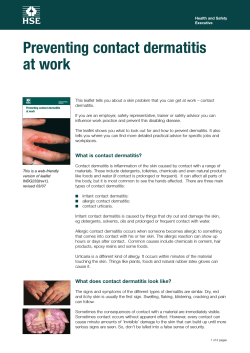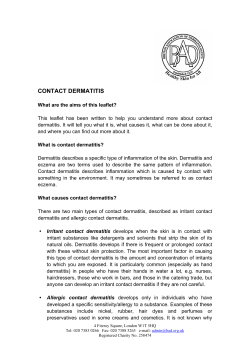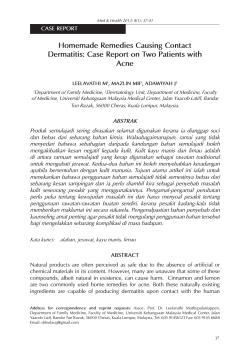
Atopic Dermatitis, Eczema, and Noninfectious Immunodeficiency Disorders Rick Lin, DO MPH
Atopic Dermatitis, Eczema, and Noninfectious Immunodeficiency Disorders Rick Lin, DO MPH July 15, 2003 Atopic Dermatitis • • • • • Aka atopic eczema Aka infantile eczema Aka flexural eczema Aka disseminated neurodermatitis Aka prurigo diathsique Atopic Dermatitis • High level of IgE antibodies to House dust mites • IgE bound to Langerhans cells in atopic skin • Food exacerbates symptoms in some patients: eggs, peanuts, cow’s milk represent up to 75% of positive test. Atopic Dermatitis • Pruritis is the hallmark of AD • Eczematous eruption leads to lichenified dermatitis • Itching precedes the appearance of lesions Infantile Atopic Dermatitis • 60% of case AD present in the first year of life, after 2 months of age • Begin as itchy erythema of the cheeks • Distribution include scalp, neck, forehead, wrist, and extensors • May become desquamate leading to erythroderma. Infantile Atopic Dermatitis • Most cases the symptoms will disappear toward the end of the second year. • The role of food allergy in infantile and childhood atopic dermatitis has been clarified • Egg, peanut, milk, wheat, fish, soy, and chicken may exacerbate infantile AD Involvement of the cheeks is characteristic of the infantile pattern of AD. Childhood Atopic Dermatitis • Characterized by less acute lesions • Distribution: antecubital and popliteal fossae, flexor wrist, eyelids, and face. • Severe atopic dermatitis involving more than 50% of body surface area is associated with growth retardation. Adult Atopic Dermatitis • Distribution: antecubital and popliteal fossae, the front side of the neck, the forehead, and area around the eyes. • Atopic individuals are at greater risk of developing hand dermatitis than are the rest of the population • 70% develop hand dermatitis some times in their lives Cutaneous stigmata • • • • Dennie-Morgan fold Pityriasis alba Keratosis pilaris Hertoghe’s sign – thinning of the lateral eyebrows • Keratosis punctata palmaris et plantaris Vascular Stigmata • Headlight sign – perinasal and periorbital pallor • White dermographism – blanching of the skin at the site of stroking with a blunt instrument – cause edema and obscure color of underlying vessels. Infection • Staph aureus – 90% of chronic lesions • Eczema herpeticum – generalized herpes simplex infection. Young children usually. • Vaccination against smallpox is contraindicated in person with atopic dermatitis. Even when condition is in remission, widespread and even fatal vaccinia can occur. Immunology • T helper cell type 2 (Th2) dominance • Th2 produces IL-4, 5, and 10 • IL-4 and IL-5 produce elevated IgE and eosinophilia • IL-10 inhibits delayed type hypersensitivity • Th2 maybe sensitive to house mites or grass pollen Immunology • Monocytes produces elevated amount of prostaglandin E2 (PGE2) • PGE2 reduces gamma-interferon production, but not IL-4 from helper cells thereby enhancing the Th2 dominance • PGE2 also directly enhances IgE production from B cells Immunology • Langerhans cells of AD patient stimulate helper T cells into Th2 phenotype without the presence of antigen • Langerhans cells have IgE bound to their suface receptors. These IgE are associated with atopic antigens, such as house dust mites Differential Diagnosis • • • • • Seb Derm Contact dermatitis Nummular eczema Scabies Psoriasis Histology • Spongiotic dermatitis • Lichen simplex chronicus • Eosinophiles may be seen Management • Protect from scratching • Adequate cleansing but not over bathing or rubbing • Gentle cleanser • Anti-histamines, especially at night • Bathing protocol • Food allergies concerns and dietary restrictions. • Hydrate skin daily with moisturizers Management • Topical steroid • Wet compress of Burow’s solution such as Domeboro. • Crude coal tar/liquor corbonis detergens (LCD) Management • “Topical FK506 (Tacrolimus) is dramatically beneficial in SEVERE atopic dermatitis” • 95% showed good improvement in Alaiti and Rusicka study in JAAD 1998, Archive 1999 Regional Eczema • • • • • • • Ear eczema Eyelid dermatitis Nipple eczema Hand eczema Diaper dermatitis Infectious eczematoid dermatitis Juvenile plantar dermatosis Ear Eczema • Most frequently caused by seborrheic or atopic dermatitis • Staph, Strep, or Psoeudomonas • Earlobe is pathognomonic of nickel allergy Eyelid dermatitis • When on one eye only, it is most frequently caused by nail polish • When both eyelids are involved, consider mascara, eye shadow, eyelash cement, eyeline, etc Nipple eczema • Painful fissuring, seen especially in nursing mothers • Maybe an isolated manifestation of atopic dermatitis • If persist more than 3 month, and/or unilateral, biopsy is mandatory to rule out Paget’s Hand eczema • Spongiosis histologically • Irritant hand dermatitis- seen in homemakers, nurses. Resulting from excessive exposure to soaps • Pompholyx- tapioca vesicles, on sides of fingers, palms, and soles • Differentials – Bullous Tinea, id, allergic contact dermatitis Treatment • • • • Barrier Moisturizer Systemic Corticosteroids Phototherapy – UVA, PUVA, Radiotherapy (Grenz Ray) Diaper dermatitis • • • • Jacquet’s erosive diaper dermatitis Pseudoverrucous papule and nodules Graduloma gluteal infantum Irritation caused by bacteria, change in the environment (wet, lower PH, feces) • Candida albicans are secondary infection. Infectious eczematoid dermatitis • Vesicular, pustular, or cursted • Ulceration and superficial infection may be present • Treatment involve the removal of irritant and antibiotic treatment. Juvenile plantar dermatosis • Begins as a patchy symmetrical, smooth, red, glazed macules on the base of the great toes • Affect age 3 to puberty. • Symmetrical lesions on weight bearing area • “toxic sock syndrome” – caused by repeated maceration of the feet by occlusive shoes and nonabsorbent synthetic socks • Virtually always resolve after puberty Xerotic Eczema • Aka winter itch, nummular eczema, eczema craquele, and asteototic eczema. • Anterior shins, extensor arms, and flank • Elderly person predisposed. • Use of bath oils in bath water is recommended to prevent water loss • Moisturizers – urea or lactic acid. Nutritional Deficiency Eczema • Localized, thickened pattern with scaling patches. • Exacerbated by nutritional deficiency Hormone Induced Dermatoses • Autoimmune progesterone dermatitis – urticaria, urticarial paplues, papulovesicular lesion, or eythema multiforme. Appear 5-10 days before menses • Autoimmune estrogen dermatitis – a cyclic skin disorder with variable morphologies. Exacerbate premenstrually or occur only immediately before the menses. Treatment with tamoxifen maybe effective. Immunodeficiency Syndromes • • • • • • • X-Linked Agammaglobulinemia Isolated IgA Deficiency Common Variable Immunodificiency Isolated Primary IgM Deficiency Immunodificiency with Hyper-IgM Thymic Hypoplasia Thymic Dysplasia with Normal Immunoglobulins (Nezelof Syndrome) Immunodeficiency Syndromes • Purine Nucleoside Phosphorylase Deficiency • Miscellaneous T-Cell Deficiencies • Severe Combined Immunodeficiency Disease (SCID) • Thymoma with Immunodeficiency • Ataxia-Telangiectasia (Louis-Bar’s S.) • Wiskott-Aldrich Syndrome Immunodeficiency Syndromes • • • • • • • • X-Linked Lymphoproliferative Syndrome Chronic Granulomatous Disease Myeloperoxidase Deficiency Leukocyte Adhesion Molecule Deficiency Chediak-Higashi Syndrome Hyperimmunoglobulinemia E Syndrome Complement Deficiency Graft-Versus-Host Disease X-Linked Agammaglobulinemia • Aka Bruton’s syndrome, sex-linked agammaglobulinemia. • Appear after 3-6 month of life • Frequent Strep and staph infection. Viral resistance intact. • IgA, IgM, IgD, and IgE are absent in the serum. IgG present with small amount • Cell-mediated immunity intact. T lymphocytes are normal, B cells are completely lacking X-Linked Agammaglobulinemia • Defect lies in the maturation block in pre-Bcell to B-cell differentiation • Protein tyrosine kinase (PTK) gene deletion and point mutation • May develop leukemia, fatal encephalitis, resporatory Isolated IgA Deficiency • Absence or marked reduction of serum IgA • 1:600 in white population, most are entirely well. • Malignancy is increased in adult with IgA deficiency. Common Variable Immunodificiency • • • • Aka acquired hypogammaglobulinemia HLA marker B8 and DR3 are affected Recurrent sinopulmonary infections B cells present but not terminally differentiated • T cells dysfunction evident Isolated Primary IgM Deficiency • Eczematous dermatitis presents in 1/5 of patient with this condition • Predisposition to bacterial infection • Defect in maturation of IgM producing plasma cell. Immunodificiency with HyperIgM • Low or absent IgG, IgE, and IgA level. Normal or elevated IgM and IgD • IVGG, and allogenic bone marrow transplant • X-linked form caused by mutation or deletion of Xq26.3-27.1 region, which encodes a ligand of CD40, gp39 • Gp39-CD40 interaction signals for Ig isotype switching. Thymic Hypoplasia • DiGeorge anomaly, aka III and IV pharyngeal pouch syndrome • Facies: notched, low-set ears, micrognathia, shorten philtrum, hypertelorism • Congenital absence of the parathyroid, thymus, and abnormal aorta • Hpocalcemia is the first sign • Aorteic and cardiac defects are the cause of death • Deletions within proximal long arm of chromosone 22 Thymic Dysplasia with Normal Immunoglobulins (Nezelof Syndrome) • Faulty development of thymus gland • Autosomal recessive • Thymus is present but under developed, no cardiac abnormalities. • Contrast to DiGeorge syndrome. Purine Nucleoside Phosphorylase Deficiency • Greatly reduced T-Cell counts, depressed cell mediated immunity • B cells and antibody formation intact • Mutation on 14q13 • Usually died of overwhelming viral infection Miscellaneous T-Cell Deficiencies • Cartilage-hair hypoplasia syndrome, AR, patient with short-limbed dwarfism, fine sparse, hypopigmented hair, defective cell mediated immunity. • Omenn’s syndrome, AR, mimic GVHD, exfoliative erythroderma, eosinophilia, recurrent infection, hypogammaglobulinema, diarrhea, hepatosplenomegly, early death by 6 month. Inefficient and abnormal generation of T-Cell receptor. SCID: Severe Combined Immunodeficiency Disease • Severe impairment of humoral and cellular immunity • Triad of Moniliasis of the oropharynx and skin, intractable diarrhea, and pneumonia. • Overwhelming viral infection is the cause of death. • Deficiency or total absence of circulating lymphocytes Thymoma with Immunodeficiency • Good’s syndrome • Deficient in cell mediated immunity and benign thymoma occurring simultaneously • Thymectomy does not affect the immunodeficiency Ataxia-Telangiectasia (Louis-Bar’s S.) • Distinctive telangiectasia in bulbar conjuctiva and flexural suraces of the arm developing during the 5th year of age • Telangiectasia occurs on butterfly are of the face, palate, ear, and exposed skin. Café au lait patches, and Graying hair also present. • Cerebellar ataxia is the first sign of this syndrome, beginning in the second year of life. • Choreic and athetoid movement present. • Persistent granulomatous plaques on the leg of child with ataxia–telangiectasia. Wiskott-Aldrich Syndrome • Triad: chronic eczematous dermatitis resemble AD, increase suseptibility to infections (OM), and thrombocytopenia purpura/hepatoslpenomegly • Death by age 6 • Accelerated IgA, IgM and IgE synthesis • T-cell decline in numbers and activity • Xp11 gene mutation. Codes for WASP protein which reorganize cytoskeleton X-Linked Lymphoproliferative Syndrome • Aka Duncan’s disease • Inability to control Epstein-Barr virus infection. • Pt normal until develop infectious Mono. • Xq26 abnormailty • B-cell lymphoproliferative disease with acquired hypoglobulinemia. Chronic Granulomatous Disease • Recurring purulent and granulomatous infections involving long bones, lymphatic tissue, liver, skin, and lung. • Deficient in one of the component of NADPH-oxidase complex, which generates superoxide. • Leads to inability to destroy bacteria per radical mechanism Chronic Granulomatous Disease • 65% of cases are the X-linked form, lacks the subunit of cytochrom b 558(gp91-phox) • Female carrier has mixed and normal and abnormal cells thus shows an intermediate phenotype. Leukocyte Adhesion Molecule Deficiency • Autosomal recessive • Recurrent bacteria and fungal infections and pus formations as a result of a block of leukocyte migration • Faulty complexing of the CD11 and CD18 integrins • Death occurs in first 4 years of life unless bone marrow transplant is undertaken. Chediak-Higashi Syndrome • Progressively degenerative, fatal, familial disease of young children • Partial oculocutaneous albinism, cutaneous and intestinal infections early in childhood • Ocular albinism is accompanied by nystagmus and photophobia. • Defect in the gene LYST, resulting in defective vascular transport to and from the lysosome Hyperimmunoglobulinemia E Syndrome • Consists of atopic-like eczematous dermatitis, recurrent pyogenic infection, high lever of IgE, elevated IgD, IgE antistaph antibodies, and eosinophilia. • Face is consistently involved. Begin early in life (2 month to 2 years) • Lesions resemble prurigo • Keratoderma of the palms and soles Job’s syndrome • Subset of HIE. • Mainly affect girls with red hair, freckles, blue eyes, and hyperextensible joints. Cold abscesses occur. Graft-Versus-Host Disease • Immunocompetent cells are intor duced as graft or blood transfusion to host who is unable to reject the graft cell. • Most commonly after bone marrow transplant. • Begins between 4-5th weeks after transplant. • Result in exfoliative erythroderma. Early, chronic graft-versus-host reaction with widespread, almost confluent hyperpigmented lichenoid papules and toxic epidermal necrosis-like appearance on knee Late, chronic graft-versus -host reaction with hyperpigmented sclerotic plaques on the back Acute graft-versus-host reaction with vivid palmar erythema Graft-versus-host reaction with early, chronic, diffuse, widespread lichenoid changes of lips Acute erosions of the buccal mucosa in graft-versushost reaction Graft-versus-host reaction; acute basal cell hydropic degeneration with interepidermal necrotic keratinocytes Graft-versus-host reaction; early chronic hyperkeratosis and hypergranulosis, irregular acanthosis, cytoid body and basal cell hydropic degeneration reminiscent of lichen planus End of Lecture…
© Copyright 2025













